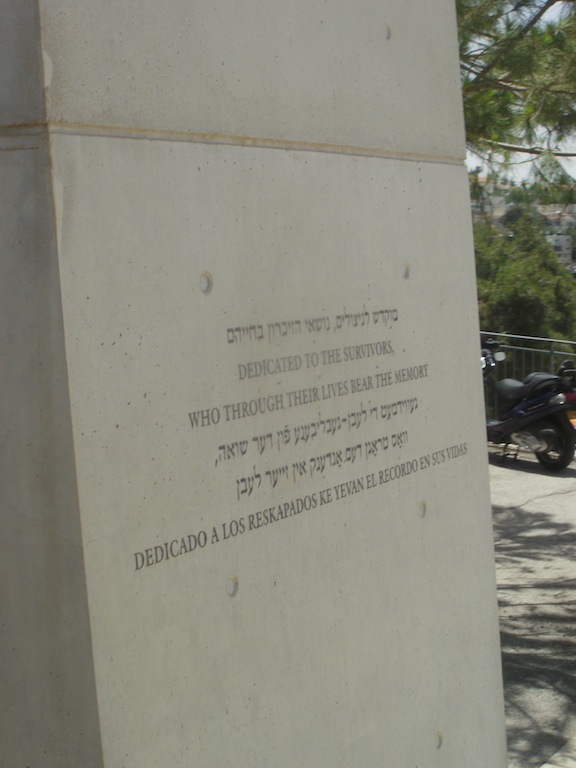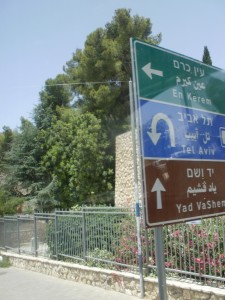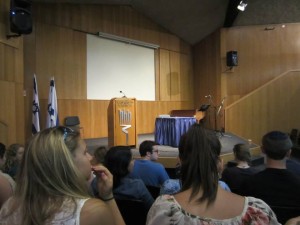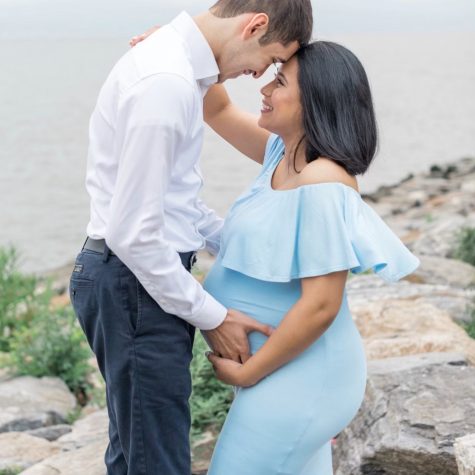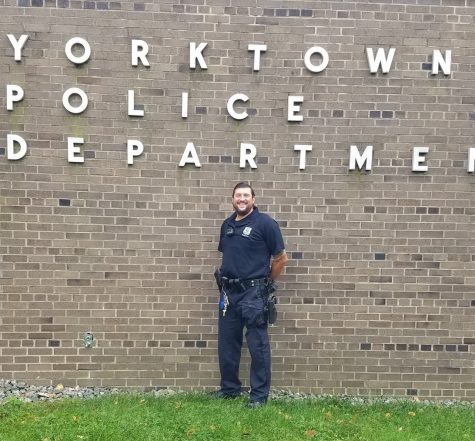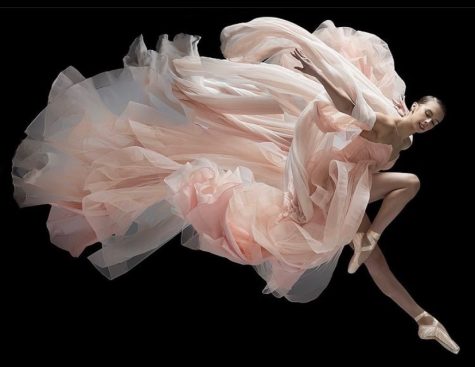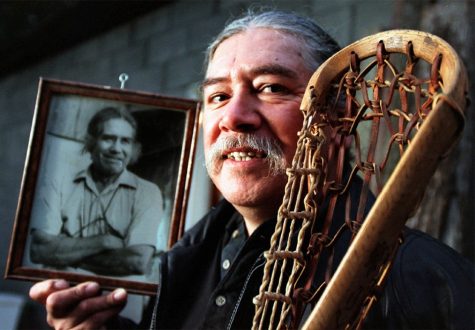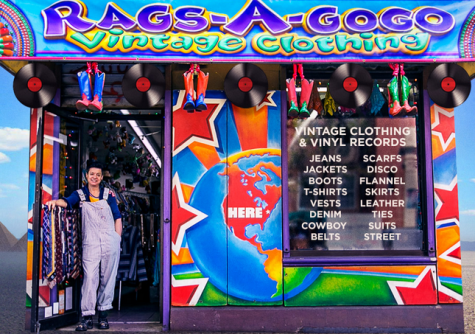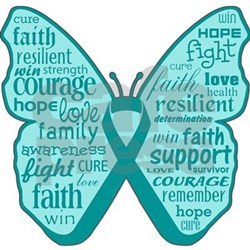The Halls Of Yad Vashem
A Holocaust Survivor Reflects On Nazi Infamy
While waiting to place my order at the deli of the supermarket, I take the blistery cold air. It hits my face as the door opens, allowing more customers to do their weekly shopping. The smell of the freshly baked bread makes my mouth water as the body odor of the woman standing behind me makes my nose scrunch up. The little boy, who looks to be about five years old, sitting in the child’s wagon in front of me with his mother, catches my eye. He is looking around, bewildered, as if he is experiencing Disney World for the first time.
“Mommy, why does that girl have purple hair?”
I look over to see the girl with the purple hair picking out plums, and I smirk to myself, wondering the same thing.
His mother remarks with a bit of enthusiasm, “She probably loves purple, so she dyed her hair that color.”
She then looks him square in the eye and says, “Don’t get any ideas,” as she tickles his tummy. He chuckles.
As we move up in the line, the boy asks his mother another question.
“Mommy, why is that kid wearing sunglasses inside?”
“He’s trying to be cool,” his mother tells him, getting a better view of the egg potato salad in the display case.
And then, the little boy asked something that I did not expect.
“Mommy, why does that man have numbers on his arm?”
I look to where the kid is pointing, and I see the elderly man reaching over to put some bananas in his cart standing in close proximity to us. His sleeves are rolled up, and all can see the remains of a tattoo.
Not just any tattoo.
It was almost faded, but one could still make out the numbers that appeared on his left forearm.
“Oh, it’s not important dear,” the mother whispers to her curious child as she moves closer up the line.
This time, she is wrong.
It is important.
*******
Six months prior to being in that supermarket, I was having the summer of my life. I had the amazing opportunity to travel to Israel on a birthright trip. It was a chance that I wasn’t going to pass up, and it was one that I would never forget. I traveled with a group of 40 people between the ages of 18-25 that were seeking the same things that I was: to understand the culture of Israel, and bring a piece back when we journey home.
Israel is such a beautiful country with a remarkable history. I was fortunate enough to visit so many wonderful places, such as an art museum full of elegant sculptures and paintings, climb Mt. Masada to see the sunrise over the Dead Sea, go river rafting on the Jordan River, and even ride on camels.
Although there were many fun outings, it was the visit to the Holocaust Museum in Jerusalem named Yad Vashem that was one of the most memorable experiences of my life. It is shaped as a triangular prism, but there is more to the museum than just having thousands of photographs and artifacts from the genocide. It displays the history of a dark time, where over six million Jews lost their lives in what we know today as the Holocaust.
*******
I was sitting in the auditorium facing the small stage with a podium in the middle. The room was filled with college aged students waiting to hear the lecture. It was early in the morning, but there was no way I was going to complain, because it was one of the few times there was air conditioning.
This was a once in a lifetime opportunity, for I realized that we would probably be the last generation that would hear from a survivor of the Holocaust.
I can recall reading Eli Wiesel’s Night in high school and learning about what he experienced, which was heartbreaking. We learned about it, briefly, in European History class during the World War II era, but reading it and hearing it first hand from someone who had experienced it had a much more profound impact.
The girl sitting next to me, Allison, had told me a story earlier that day that she had met a survivor when she was little. All she remembered was that her name was Dana and she was only seven years old when she was separated from her brother, who had gone to Auschwitz. Dana had actually escaped with a family friend to the United States after her parents were killed when the Nazis burned down her old house. It wasn’t until years later, Dana found out that her brother had survived and had tracked him down. Their relationship was a lot closer after the fact for they knew they were grateful to have one another back in their lives.
I thought that after all that, they at least had somewhat of a happy ending, while many others did not.
Sitting in the auditorium, I took out my notebook in preparation for taking notes. In a few minutes, someone would be standing right in front of me, about to tell a story that would be both gruesome, heart- wrenching and worst of all, true. I couldn’t even prepare myself for what he would say but I knew that it would be hard to swallow.
I was wondering to myself, will this man be in poor health?
Will he be able to walk down the stairs?
Will he have trouble remembering a few things about his life?
How old is he now? He must be in his 80s or even 90s.
And then, he came in.
*******
His presence was noticed immediately. Everyone in the room had stopped talking to the person they were sitting next to when he entered the room. You may say it was a sign of respect, or maybe even dread, for we were about to hear his story from the primary source.
He was a short, plump man with thinning white hair and round spectacles.
He was able to get down the stairs quite rapidly for someone his age without any assistance. He wore a long sleeved periwinkle collared-shirt under a dark navy sweater vest with navy slacks. He wore a yamaka on top of his head. He sat beside the podium, took a sip of water, and then he began to tell us his story.
His name, he told us, was Asher Ud.
He was soft spoken with a slight Yiddish accent which made it a bit difficult to hear, but everyone was listening so attentively, you would try to hang on to every word.
“You should know that I haven’t spoken about the Holocaust for over 50 years. After a visit to Poland, I was able to tell my story for the first time.”
Since then, he has shared his testimony to countless people all over the word, and will continue to do so until he has no more breath in him, for he believed that that was the only reason he had survived.
To share his story.
He told us that he was born in Poland in the year 1928. He spoke about his mother and brother, and how they were taken away, leaving him to have to take his brother’s job at the factory to help his family earn money. He was only 11 years old when he lost both his two brothers, as well as both of his parents. Just a child, and he was on his own.
Then, he told us that he was taken. Not just anywhere, but to a place that strikes horror for everyone who knew that those who went there, were, rarely if ever, seen again.
Auschwitz.
We all knew that of all the concentration camps, Auschwitz was the one that people had feared the most.
When he arrived at the concentration camp, the first thing that he noticed was the smell.
A burning smell.
He stood in line amongst the other boys where they were given a number and a new name.
He made his way to a barracks where he would live for the next six years with 1,200 boys. Out of those 1200, only two had survived.
Asher Ud was one of those two people.
After he was liberated from the concentration camp in 1945, he moved to Jerusalem. There, he enlisted for the Israeli army and took part in Israel’s war of Independence in 1948.
He had met his wife in Jerusalem, and has three children and ten grandchildren.
He told us that he has never even told his story to his wife, or to his children. They had known that he was a survivor of the Holocaust, but he couldn’t bear to tell them his story. He said that he never really had a childhood, so he wanted to protect his family from his past and keep them innocent for as long as he could.
He sighed, not in relief, but because he believed that it was a lot for us to absorb as he observed his audience and their reactions.
Some people were in tears. Others had fallen asleep. And even some were just sitting there, starring back at the man who had been through so much, in shock that he had come so far.
He waited another minute, after taking another sip of water and patted his chin with a handkerchief from his pocket before looking back up at all of us and asked, “What questions do you have for me?”
I thought that was a strange question. Usually, people ask ‘Do you have any questions?’ Then, I realized as all our hands rose in unison, his phrasing was actually correct.
“Who do you blame for what happened to you?” someone who was sitting behind me asked.
“Those damn Germans,” he replies sternly. “I still hate them.”
“Do you blame God at all for what happened to you?” a girl from the other side of the auditorium asked.
He didn’t answer right away. It was a very difficult question to answer for someone who had prayed to somehow escape Auschwitz and he would have to contemplate an answer, but he simply said two words.
“I can’t.”
It wasn’t “I can’t” answer the question. It was “I can’t” blame God for what happened. He tells us he is not a religious man, but he does believe in God.
“As simple as it would be to blame God, I cannot.”
“Do you still have the numbers on your arm?” a boy in the front row asked.
Again, he didn’t answer right away. He smiled at the boy and then started to roll up the sleeve on his left arm showing all of us the ink that was imbedded in his skin.
Although in small print, it was still legible to see the numbers residing on his forearm.
“It’s my reminder,” he told us.
A reminder of his struggles and his ability to triumph over such as horrific time.
He told us he had time to answer one more question before he had to leave.
The honor was mine.
“Do you have any regret?” I asked.
Unlike the previous questions, he answered almost immediately.
“I do regret having to change my name, but it was something that I had to do.”
And with that, he thanked us all for being there, for hearing his story, and for not forgetting what has happened. He tells us that he has visited the museum many times and it still gets to him. He tells us that we should go through each exhibit of the museum, taking in each picture and artifact and to feel whatever it is we feel.
“Just take it with you.”
As he gathered his belongings, we applauded. It may have been a bit cheesy, but we all get up and give him a standing ovation as if he has performed the finale of a play. But this was no performance. It was real.
As we grabbed our own belongings to leave, we embarked on the second half of our visit to Yad Vashem.
The Holocaust Museum Memorial.
*******
We were repeatedly told “No photographs.”
Our tour guide for the museum, David, told us that the prism shape of the exhibit was built to bring in the daylight, with a skylight that allows the light to contrast with the darker areas of the exhibit. The prism was built with exhibition galleries on both sides. The darkest area is located at the beginning of the museum, which marks the beginning of the Holocaust.
David had told us that there were impassable gaps extending along the width of the floor that represent physical obstacles that guide visitors into the adjacent galleries, allowing you to see the other end of the prism clearly.
The displays of original artifacts, documentation, testimonies from survivors, film, clothing, books and diaries, letters, and works of art, accentuate the stories of what has happened.
One photograph that stood out amongst the rest was of two Nazi soldiers throwing a naked, lifeless body into a ditch where other lifeless bodies were laid. The photograph was taken from inside the ditch. David tells us that the photographer wasn’t there to capture evidence of what was happening but to glorify what was happening. How anyone could glorify the persecution of innocent people is hard to swallow.
David gives us a few minutes to look around at other photos when I noticed the Asher Ud was on a tour of his own. He was looking at each artifact, as if they represented each person they had belonged to, and mumbled something that was incoherent. He could have been praying for each person who had lost their lives or praying, but it was clear that he was emotional.
There was a small corner of one of the exhibits where the ground was of cobblestone with a sign above it that read “Arbeit Macht Frei” (“Work makes you free). David asked all of us to stand on it. It was a tight fit for all 40 of us, and it was hard to keep our balance. David told us that this was what it was like for those who were sent to the Auschwitz concentration camp. He tells us to imagine standing barefoot on the cobblestone. Even though, I was not barefoot, I could feel the unevenness of the floor under my shoes, which made me lose my balance several times.
As we continue through the exhibit, Asher Ud catches my eye again as he stares up at the sign that had been at the entrance of Auschwitz. I realize as others step around him to stand on the cobblestone, he only stares at it. He stares at the cobblestone for a couple of minutes, not even touching it, before continuing on through the museum.
As our group moved on, we traveled from one exhibit gallery to the next seeing letters to loved ones, candles that were used for Shabbat, and then, the shoes.
When they arrived at the concentration camps, they were stripped down. Their clothes in one pile, socks in another, hair in another, and shoes in another. The museum had its own pile of shoes that was embedded into the floor under glass.
They all looked the same. They were all brown, probably from being in mud. Except for one.
It was red.
That one red shoe, with the buckle still fastened, must have belonged to a little girl.
*********
As our tour came to an end, the triangle prism is much brighter with the exit displaying from the mountain’s slope of a picturesque view of Jerusalem.
Before we leave, we are taken into the last gallery.
They call it the Hall of Names.
The room is round and houses the extensive collection of “Pages of Testimony,” which are the biographies of each victim of the Holocaust, over two million pages worth.
David tells us that the ceiling of the Hall is made up of a 10 meter-high cone stretching toward the sky, and displays somewhere around 600 photographs and pieces from the Pages of Testimony. The space actually consists of two cones- one that is sunken 10 meters into the bedrock, while the other is skyward. The Testimony are symbolic tombstones that are filled out by survivors, in memory of their loved ones. He says that there are still some blank areas for those who are still missing from the list. The exhibit represents only a portion of the murdered six million men, women and children of Jewish decent. As visitors stand on the platform, the pictures of the murdered look downward from above, while their faces are reflected in the water at the base of the cone. Their portraits reflect in the water at the bottom of the cone, which symbolize those faces who have not yet been discovered.
As Asher Ud appears into the room, he stops and looks around. It is as if he is experiencing the Hall for the first time. He finds an open area by the railing. Looks up at all the photographs, then slowly looks down to the water. But his eyes are closed. He is praying again. For a man who had not been very religious, he has certainly come to appreciate all that he has.
As he lifts his head and turns to leave, I wonder if he recognized any of the photos as family members. As he stands in the frame of the door he turns around one more time, looking at the entity of the Hall, and leaves.
I wonder if he believed that that was his last time visiting the museum.
********
It is hard to truly understand what someone like Asher Ud had gone through without having lived through it ourselves. To have some people say that it never happened in the first place is cruel to all those who not only lost their lives, but for those who lost their family members.
It is obviously how deeply affected he was by the Holocaust, not by what he said, but his mannerisms and the way he spoke.
It is a wonder what Asher Ud’s life would have been life today, had he not experienced such a horrific event. Would he have had a close relationship with his parents or his brother? Would he be living in Israel?
Who knows for sure how different his life would be if he hadn’t had that experience.
*******
“Mommy, why does that man have numbers on his arm?” the little boys asks, tugging on his mother’s arm as the line at the supermarket moves up.
“Oh, it’s not important dear.”
It is important, I think to myself, knowing it isn’t my place to tell a little child about such a tragic event that has hurt so many people.
Maybe his mother doesn’t know the answer.
Maybe, she never learned about it in European History class.
Maybe, she never read Eli Wiesel’s Night.
Maybe, she never met a survivor who told them their story about the Holocaust.
As she picks up her son out of the wagon, I notice her necklace. The Star of David dangles around her neck.
Then I realize that maybe she just wants to keep her child innocent for as long as she can too.



